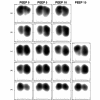Changes in regional distribution of lung sounds as a function of positive end-expiratory pressure
- PMID: 19426555
- PMCID: PMC2717423
- DOI: 10.1186/cc7871
Changes in regional distribution of lung sounds as a function of positive end-expiratory pressure
Abstract
Introduction: Automated mapping of lung sound distribution is a novel area of interest currently investigated in mechanically ventilated, critically ill patients. The objective of the present study was to assess changes in thoracic sound distribution resulting from changes in positive end-expiratory pressure (PEEP). Repeatability of automated lung sound measurements was also evaluated.
Methods: Regional lung sound distribution was assessed in 35 mechanically ventilated patients in the intensive care unit (ICU). A total of 201 vibration response imaging (VRI) measurements were collected at different levels of PEEP between 0 and 15 cmH2O. Findings were correlated with tidal volume, oxygen saturation, airway resistance, and dynamic compliance. Eighty-two duplicated readings were performed to evaluate the repeatability of the measurement.
Results: A significant shift in sound distribution from the apical to the diaphragmatic lung areas was recorded when increasing PEEP (paired t-tests, P < 0.05). In patients with unilateral lung pathology, this shift was significant in the diseased lung, but not as pronounced in the other lung. No significant difference in lung sound distribution was encountered based on level of ventilator support needed. Decreased lung sound distribution in the base was correlated with lower dynamic compliance. No significant difference was encountered between repeated measurements.
Conclusions: Lung sounds shift towards the diaphragmatic lung areas when PEEP increases. Lung sound measurements are highly repeatable in mechanically ventilated patients with various lung pathologies. Further studies are needed in order to fully appreciate the contribution of PEEP increase to diaphragmatic sound redistribution.
Figures






Comment in
-
Acoustic monitoring--super sonics?Crit Care. 2009;13(4):162. doi: 10.1186/cc7908. Epub 2009 Jul 3. Crit Care. 2009. PMID: 19664167 Free PMC article.
References
-
- Leblanc P, Macklem PT, Ross WR. Breath sounds and distribution of pulmonary ventilation. Am Rev Respir Dis. 1970;102:10–16. - PubMed
-
- Ploy-Song-Sang Y, Martin RR, Ross WR, Loudon RG, Macklem PT. Breath sounds and regional ventilation. Am Rev Respir Dis. 1977;116:187–199. - PubMed
-
- Ploy-Song-Sang Y, Macklem PT, Ross WR. Distribution of regional ventilation measured by breath sounds. Am Rev Respir Dis. 1978;117:657–664. - PubMed
-
- Gavriely N, Cugell DW. Airflow effects on amplitude and spectral content of normal breath sounds. J Appl Physiol. 1996;80:5–13. - PubMed
Publication types
MeSH terms
LinkOut - more resources
Full Text Sources

